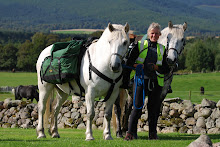 One of the (many) things I particularly enjoy about off-road riding is spotting wildlife. Often animals are less fearful of a person on a horse than a person walking, and you can get quite close without disturbing them.
One of the (many) things I particularly enjoy about off-road riding is spotting wildlife. Often animals are less fearful of a person on a horse than a person walking, and you can get quite close without disturbing them.On our recent trip I had hoped very much to spot some beaver which are kept locally - although I knew it was unlikely, as they have pretty nocturnal habits and are most easily seen in the late evening. Riding past their home, then, there was sadly no sign of them, but many indications of their industry, like these downed trees with beavery teethmarks!
Some of the trees were positively huge - I'm not sure how long it would have taken them to knaw their way through some of the larger specimens.
Partner Bill has in the past done some veterinary work on this colony (they are prone to a certain kind of fluke I believe). He was called out to post-mortem one which had been found dead. 'Bloody fluke, I suppose' he grumbled as he set off - but no. In this case, the beaver had been knocked on the head by a tree which fell on it after it had bitten its way through the trunk. Very sad, but perhaps that particular animal was better out of the beaver gene pool - it sounded like a prime candidate for the Darwin Awards.
The ponies took no notice of the beaver colony: not so when we later passed a wild boar enclosure on the same estate. Lots of sniffing and snorting from them as they caught a whiff of pig! Unfortunately the undergrowth was so dense we didn't actually see any - although we have many times before - the little stripey babies are enchanting, Daddy a bit less so.
Most people who keep horses are ever on the alert for mice and rats around the feedhouse area. Since our property is bounded on three sides by running water, rats (yuk) have always been in evidence around here - although much less so recently, which I have put down to the efforts of our ratophile terriers, Oddjob and Mabel.
Although all our grain, feed etc is kept safely in an old chest freezer in our feedhouse, every so often you hear a scurrying when opening the feedhouse door, with some rat or mouse chancing their luck. My strategy is always to send the terriers in first, and let them deal with it, which they do extremely efficiently and quickly.
Hearing a tell-tale patter one morning, I sent the 'girls' in. Suddenly all hell broke loose, with yelping, yapping, and crashing going on. That didn't sound like a rat or mouse! Terrified that they might have cornered a cat which had sneaked in overnight, I rushed in to call off the dogs - to find them in the process of despatching a young male mink.
 Mink are a huge problem in the rivers in this area, as in many others in the UK. They are not native - they are from North America and were brought over and bred for the fur trade. Many subsequently escaped (or were set free by well-meaning animal rights protesters).
Mink are a huge problem in the rivers in this area, as in many others in the UK. They are not native - they are from North America and were brought over and bred for the fur trade. Many subsequently escaped (or were set free by well-meaning animal rights protesters).Whilst I'm happy that the fur farms no longer function, the ones which have escaped (and bred) have murdered everything within sight of British rivers - fish, birds, voles and many other species.
Many landowners and farmers are attempting to control the population via mink rafts on rivers, which have a clay bottom where you can track mink visits - they are then trapped and humanely destroyed. We, too, are part of this scheme - needless to say, our mink rafts have never seen so much as a pawprint. Obviously this young fellow preferred the easy pickings around the feedhouse - perhaps it was him who was responsible for the recent lack of rodents around the place?
The terriers survived their experience without so much as a scratch - a miracle really, as mink are extremely aggressive when cornered and have very sharp teeth. The dogs' only complaint is that there isn't a mink in there every morning when they rush in excitedly, ready for a thrilling battle.



